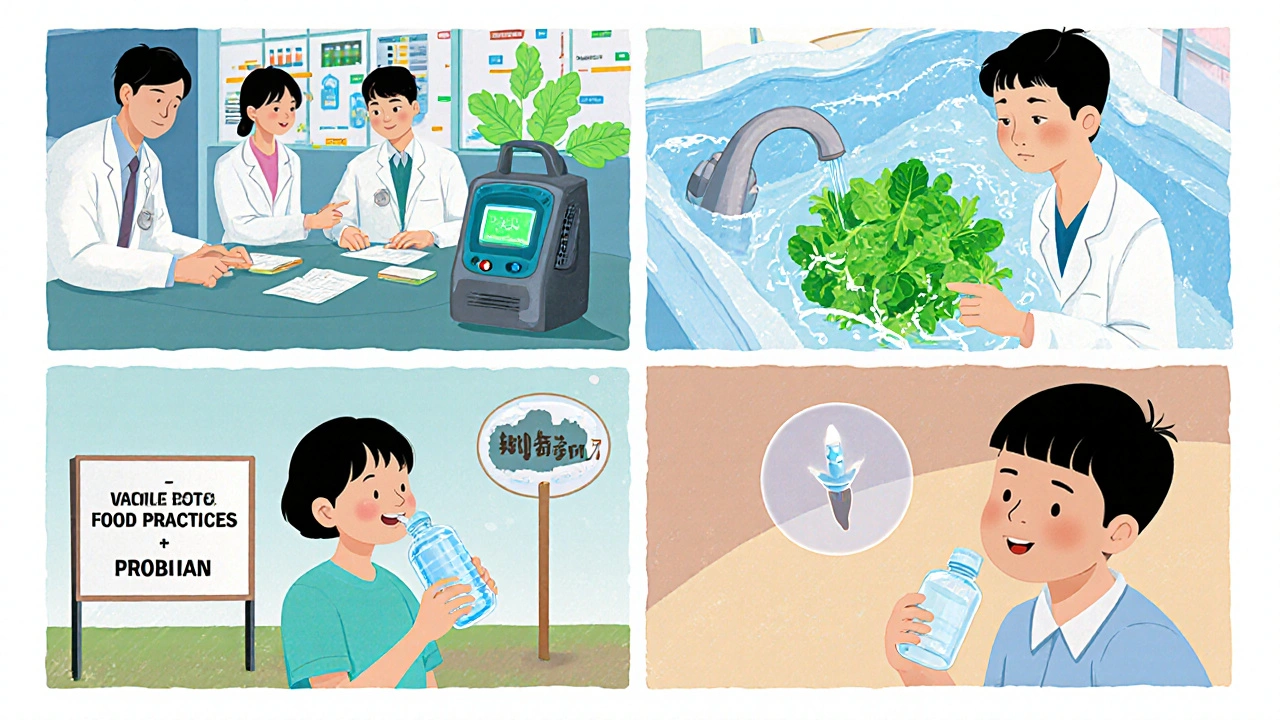Antibiotic Resistance in Enteric Infections: Risks, Impact & Prevention
 Oct, 21 2025
Oct, 21 2025
Antibiotic Resistance Risk Calculator
Antibiotic resistance is a growing global health threat that occurs when bacteria evolve mechanisms to survive drugs designed to kill them. This calculator helps you understand your personal risk of contributing to resistance based on your antibiotic usage patterns and lifestyle.
Antibiotic Resistance is a growing global health threat that occurs when bacteria evolve mechanisms to survive drugs designed to kill them. When this phenomenon spreads to the bacteria that cause Enteric Infections, the result is harder‑to‑treat diarrheal disease, longer hospital stays, and higher mortality rates. In this article we break down how resistance emerges in the gut, which pathogens are most worrisome, and what you can do today to protect yourself and your community.
Why the Gut Is a Hotspot for Resistance
The intestines host trillions of microbes that constantly exchange genetic material. This environment fuels Horizontal Gene Transfer, a process where resistance genes hop from one bacterium to another via plasmids, transposons, or bacteriophages. When a patient takes an antibiotic for a respiratory infection, the drug also reaches the gut, killing susceptible bacteria and leaving a vacuum that resistant strains rush to fill.
- Selective pressure: Each dose of a drug creates a survival challenge, giving resistant microbes a competitive edge.
- High bacterial density: The gut holds more bacteria per gram than any other body site, increasing the odds of gene exchange.
- Co‑colonisation: Pathogenic and harmless bacteria share the same niche, allowing resistance genes to jump across species.
Key Enteric Pathogens and Their Resistance Trends
Not all gut bugs pose the same level of risk. Below is a snapshot of the most common culprits and the drug classes they’re outpacing.
| Bacterium | Primary disease | Top resistant drug class | Key resistance mechanism |
|---|---|---|---|
| Escherichia coli | Traveler’s diarrhea, urinary‑tract infection (secondary) | Fluoroquinolones | Mutations in gyrA/parC |
| Salmonella enterica | Food‑borne gastroenteritis | Third‑generation cephalosporins | Extended‑spectrum β‑lactamases (ESBL) |
| Campylobacter jejuni | Campylobacteriosis | Macrolides | 23S rRNA mutations |
| Clostridioides difficile | Antibiotic‑associated colitis | Metronidazole (reduced efficacy) | Reduced drug uptake, toxin over‑production |
These trends are monitored by the World Health Organization and national bodies such as Australia’s Therapeutic Goods Administration. In 2024 the WHO listed fluoroquinolone‑resistant E. coli as a high‑priority pathogen for new drug development.
Clinical Consequences of a Resistant Enteric Infection
When a standard antibiotic no longer works, clinicians must turn to broader‑spectrum or intravenous options. This shift brings several downsides:
- Delayed recovery: Patients may stay sick for weeks instead of days.
- Increased healthcare costs: IV therapy, longer hospital stays, and extra lab tests add up quickly.
- Higher risk of complications: Untreated diarrhea can lead to dehydration, electrolyte imbalance, or sepsis, especially in the very young, elderly, and immunocompromised.
In a 2023 Australian cohort, 12 % of patients hospitalized for severe salmonellosis required second‑line carbapenems because of ESBL‑producing strains, and the mortality rate jumped from 1.8 % to 4.5 %.

Public Health Ripple Effects
Resistant enteric infections don’t stay confined to the person who contracts them. Fecal shedding of drug‑resistant bacteria can contaminate water sources, food production lines, and household surfaces. Outbreaks linked to contaminated leafy greens or raw poultry have spread across states, forcing recalls and costing the food industry billions.
Moreover, the gut acts as a reservoir for resistance genes that can later jump to more dangerous pathogens, such as methicillin‑resistant Staphylococcus aureus, via plasmids carried in fecal matter.
How to Slow the Spread: Strategies for Healthcare Systems
Combating resistance requires coordinated action on several fronts.
- Antimicrobial stewardship: Hospitals now employ teams that review every antibiotic prescription, ensuring the right drug, dose, and duration.
- Rapid diagnostics: Point‑of‑care PCR tests can identify the causative pathogen within hours, allowing targeted therapy instead of broad‑spectrum empiric use.
- Surveillance networks: Programs like Australia’s National Antimicrobial Resistance Surveillance System (NARSS) track resistance trends and issue alerts to clinicians.
- Vaccination: Oral vaccines against Vibrio cholerae and upcoming candidates for enterotoxigenic E. coli reduce infection incidence, cutting antibiotic demand.
- Infection control in food production: Good Agricultural Practices (GAP) and Hazard Analysis Critical Control Points (HACCP) limit bacterial contamination before it reaches the consumer.

What Individuals Can Do Right Now
Even without a prescription, you have a role in protecting gut health.
- Only use antibiotics when prescribed. Finish the full course, but don’t ask for leftovers or extra pills.
- Practice safe food handling. Wash produce, cook meat to safe temperatures, and avoid cross‑contamination.
- Stay hydrated and seek medical care early. Dehydration worsens outcomes; early diagnosis often means a narrower‑spectrum drug works.
- Consider probiotic support. Certain strains (e.g., Lactobacillus rhamnosus GG) can restore gut balance after antibiotics, though they’re not a substitute for proper treatment.
- Travel wisely. In regions with high rates of multidrug‑resistant E. coli, use bottled water and avoid street‑food salads unless you’re sure they’re washed with safe water.
Future Outlook: Research and Policy Directions
Scientists are exploring novel approaches such as bacteriophage therapy, CRISPR‑based gene editing to disable resistance genes, and narrow‑spectrum antimicrobial peptides that target specific pathogens without disturbing the broader microbiome. Policymakers are drafting stricter regulations on antibiotic use in livestock-a major source of resistance genes entering the human food chain.
Until these breakthroughs become mainstream, the best defense remains vigilance, responsible prescribing, and public education.
Why do antibiotics affect gut bacteria even when I’m treating a lung infection?
Oral antibiotics travel through the bloodstream to every part of the body, including the intestines. This exposure kills susceptible gut microbes, creating space for resistant strains to multiply.
What are the warning signs of a drug‑resistant enteric infection?
Persistent fever, diarrhea lasting more than a week despite antibiotics, blood in stool, or worsening dehydration are red flags. Prompt medical review is essential.
Can probiotics prevent antibiotic resistance?
Probiotics help restore a healthy balance after antibiotics but don’t stop resistance from developing. They’re a supportive measure, not a cure.
How does travel increase my risk?
In many low‑ and middle‑income countries, food and water are contaminated with multidrug‑resistant E. coli and Salmonella. Eating uncooked foods or drinking untreated water can introduce these organisms into your gut.
Should I ask my doctor for a rapid test before taking antibiotics?
Yes. Rapid molecular panels can pinpoint the pathogen and its resistance genes, allowing a targeted prescription and avoiding unnecessary broad‑spectrum drugs.

Jake Hayes
October 21, 2025 AT 00:34Antibiotic overuse is the root cause of gut resistance; stop prescribing them for viral infections.
parbat parbatzapada
October 27, 2025 AT 22:20They’re hiding the truth, the pharma giants want us sick so they can sell more drugs.
My neighbor swears the water is tainted with secret‑lab bacteria.
Ericka Suarez
November 3, 2025 AT 21:00America has the best doctors, yet even they can’t stop the stealthy spread of resistant bugs.
We need to stop the foreign labs from dumping their experiments in our farms.
Erika Thonn
November 10, 2025 AT 19:40One might ponder whether the gut is merely a battlefield or a laboratory where evolution conducts its silent experiments.
The incessant flow of antibiotics acts like a selective fire, scorching the susceptible and allowing the hardy to thrive.
Every plasmid that slips between microbes is a whispered promise of tomorrow's challenge.
In this microscopic theater, humans are both audience and unwitting actors, feeding the script with every prescription.
The notion of horizontal gene transfer feels almost poetic, a Darwinian chorus across species.
When a lung infection is treated, the drug percolates to the intestines, reshaping the microbial skyline.
This reshaping is not benign; it creates niches where resistant strains set up camp like invaders.
Such invasions translate to longer hospital stays, higher costs, and a dread of untreatable disease.
Consider the ripple effect: fecal shedding of resistance genes contaminates water, food, and the very air we breathe.
The microbial world does not respect borders; resistance travels from one continent to another via travelers and trade.
Vaccination emerges as a shield, not just against the pathogen but against the downstream demand for antibiotics.
Rapid diagnostics are the lantern that guides clinicians through the fog of empirical treatment.
Surveillance networks act as the early warning system, mapping the shifting terrain of resistance.
Ultimately, stewardship is a moral compass, urging us to preserve the efficacy of drugs for future generations.
Rachel Valderrama
November 17, 2025 AT 18:20Wow, a 15‑sentence saga – did you write that after a marathon of coffee? 😂
Brandy Eichberger
November 24, 2025 AT 17:00Hey there! Great breakdown – really appreciate the friendly tone and thoroughness.
Eli Soler Caralt
December 1, 2025 AT 15:40Thanks! i think the gut microbe discussion is so deep… sometimes i get lost in the details 😅🦠
Eryn Wells
December 8, 2025 AT 14:20Everyone, let’s remember that education and community support are key 🌍✨. Sharing safe food practices can make a big difference!
Kathrynne Krause
December 15, 2025 AT 13:00Absolutely! 🌈 Keep spreading the word, stay vibrant, and let’s champion gut health together! 🚀